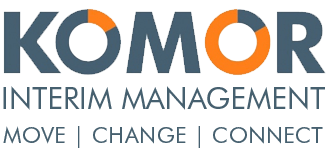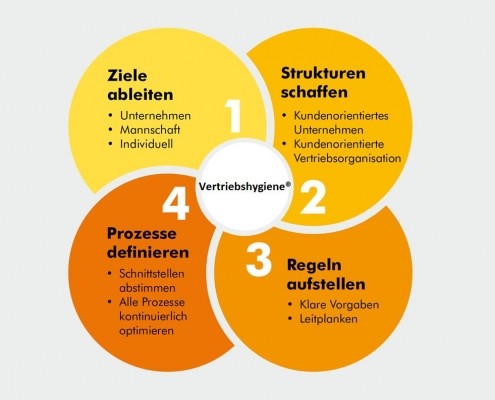Structuring Sales Success through Vertriebshygiene®
“WE ARE ALL IN SALES” is the credo of a successful organization.
How do we create a customer-focused corporate culture that is lived by everyone?
How can the company processes be aligned with the customer?
How do we increase the effective sales working time at the customer?
„I am totally convinced that the more agile a sales organization is to be, the more clearly the rules and scope must be defined. Rules and automatisms create freedom of manoeuvre. Only in this way is it possible for the local salesperson to quickly make clear statements to the customer’s purchasing team. This creates self-confidence in the employee, has a highly qualified effect and accelerates the decision-making process at the customer. This clear assignment of KPI-controlled implementation competencies is part of my concept of Vertriebshygiene®“
“No agility without clear rules”
1 Derive Objectives
Distribution cannot be seen in isolation. Therefore, all adjacent areas should be included in the considerations. The sales strategy can result in specific goals for the most diverse departments. All departments must be organised according to market requirements and customer needs. “WE ARE ALL IN SALES” is the credo of a successful organisation. For this reason, the sales targets must be broken down to business units, groups and employees.
2 Creating Structures
Creating structures (customer-oriented company, customer-oriented sales organization). Starting from the fundamental question of what the market needs and what the customers demand, the organisation should be set up in such a way that a high level of service for the customer can be achieved with the leanest possible processes, little duplication of work and a high level of added value within the sales process. The basis for the organization can be the classic ABC analysis. As an example, I would like to mention the intensification or establishment of a key account management, which is responsible for the systematic analysis and long-term management of buying and potential strategic customers.
3 Set Up Rules
For larger organisations it is definitely worthwhile to set up a sales manual in which all processes and specifications (e.g. target contribution margins, pricing policy, Key Performance Indicator KPI, visit frequencies, handling of visit reports, signature regulations and bid specifications) are regulated and defined. In order to ensure that new rules are implemented and adhered to, strict adherence to the new procedures must be demanded at the beginning – I call this “Vertriebshygiene”.
4 Define new Key Performance Indicators
The expensive resource of sales must be clearly and strictly controlled. The entrepreneur should know where sales can achieve optimal results and include this in the specifications for the sales team. Huckemann and Schmitz recommend implementing these eight categories as Sales Key Performance Indicators (KPI) in order to record all relevant information and use it as a standard in the company:
- Market perspective: Own market share and that of the main competitor, as well as a customer satisfaction index
- Results and forecasts: Sales and contribution margins per sales channel, product group, evaluable by region and per sales employee
- Efficiency in distribution: Cost of distribution as a percentage of sales
- Sales productivity: Revenue per salesperson, per customer class, customers won and lost
- Sales activities: Total number of visits, per sales representative, region, customer segment and sales channel
- Sales employees: Average age, length of service, fluctuation
- Products and innovations: Share of sales of old versus new products
- Leadership: Number of coaching days with the sales staff, development meetings
5 Define Processes
Define processes (coordinate interfaces, continuously optimize all processes, process-oriented job descriptions)
- Process quality: How completely and flawlessly are customer requirements and expectations fulfilled?
- Adherence to delivery dates: How quickly are customer requirements satisfied and how well are agreed deadlines met?
- Process costs: Which costs or which resources are used for the production of customer services?
To ensure process quality, clear interfaces must be agreed with all surrounding departments. The tasks defined in the interface lists are then reflected in the respective process-oriented job descriptions of the sales staff or the employees in the other departments. The process description specifies the contents for the job description. Experience has shown that this procedure takes a relatively long time (several months), as all processes occurring in the respective department must first be defined. Afterwards it is discussed which processes belong to the sales department (indoor service, field service, customer service, . . . ) and which to other departments.
Source: Ralf H. KOMOR – “Agile B2B Sales in the age of digitalisation”.
This is an extract from the book Chefsache Interim Management, Springer Gabler Verlag, 2018
I SUPPORT YOU ON THE WAY TO YOUR SUCCESS
I am a strategist, an innovator, an unconventional thinker, a mover and shaker and therefore I do the right things sooner and better.
And with pleasure also for you.
Together we can discover new market opportunities, steer product branding into the right direction, understand your customers better – and stand out from the competition with tailor-made products for your target group. All this leads to more customer satisfaction, greater customer lifetime value and more sales potential.
Can you afford not to go for it?





